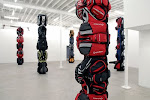Caitlyn Bierman
"We're here because we've always been here, and we will always be here," Laura Norton, 2001. As a member of the Kahnawa'ke kehro:non tribe, otherwise known as the Mohawk Indians, Laura sums up in this simple sentence the museum's purpose. This museum exists not only to display the artwork created by the American Indians, but also to share their stories of their history and the present.
The National Museum of the American Indian uses artifacts, current artwork, photos, stories, videos, music and dialogue to tell the story of the American Indian people. Each exhibit is comprised of smaller exhibits each about a different tribe. The museum curators worked with people from these tribes, chosen by their tribes to create the exhibits. The stories, comments, and dialogues are all first person accounts. The videos and first person accounts make this museum interesting because it connects the audience to the American Indians. A major message the museum is trying to share is that American Indians are still alive today because of "survivance", or doing what they can to keep their culture alive. The exhibit "our lives" explores the ways these communities are sustaining their traditions from the past to the current day. The Kumeyaay people have a "star gathering". Young people in the video featuring this celebration explain how it allows them to understand their identity as American Indians as well as learning about their culture, having fun and uniting their people.
This museum is made for all audiences. An American Indian can visit, and learn about other tribes, or appreciate the museum's collection of artifacts and artwork. A non-American Indian can visit and learn about this culture that co-exists in their own country. Some American Indians live in communities together and go to schools where they learn about their own culture and prepare to live in today's world.
This museum is unique and exciting. It is celebrating and highlighting these exciting American people. Their artwork, clothing, dolls, arrowheads, etc are impressive as well as the stories and opinions they have to share.

The American Indian museum is a terrific museum which appeals to what I would believe, the highest variety of visitors a year. The newer and modern style pulls together art, history, truth, and imagination all together, and plain and simple, has more to offer then the traditional museum. Because the main focus is the American Indian, and not a specific genre within these people, the museum appeals to a huge range of visitors. The learning of different tribes heritage involves more than a piece of paper with words. The use of envolvement and interaction with the use of artifacts, actual events, video, pictures, and props draws in the attention of any age range.
ReplyDeleteAlthough, the museum is very enjoyable and a top on my list, the idea of stereotype and capitalism has poisoned the museum. The first problem I encountered was before I even stepped through the front door. The architecture is supposed to repersent the natural, organic curves of the earth, which I understand but the use of a light color sandstone rocks to create the outer core I am in disagreement with. This portrays the image of the desert or western rocky area, and this being the American Indian museum, it gives off the idea that those tribes in the western region of america are the only tribes being talked about inside. This also pushes the idea of stereotyping or making to please the idea of what we think the native american is, by using nothing but the land to repersent them. Another example is, the giant boulders and water with waterfall in the front. This is the exact opposite of the sandstone walls towering behind them. Although the use of these items now opens up to a much wider location of tribes, it is physically unbearing and clashes with one another.
The other disease within the museum is the use of the girft shop and profit. To go along with what the museum is teaching us about the native people, with their use of the land and morals, they are once again doing the exact opposite and are jacking the prices on souvenirs and even food skyhigh. This is the prime idea of capitalism, and the knowledge of the majority of visitors being tourists, they are totally taking advantage of them and only see profits in their eyes. I understand the museum is free, but how much is public or government funding is there, how much money is going to these tribes that are featured in the museum, and how much profit is going into the pockets of the higher level of the museum?